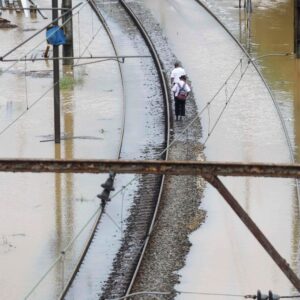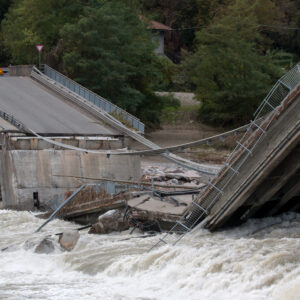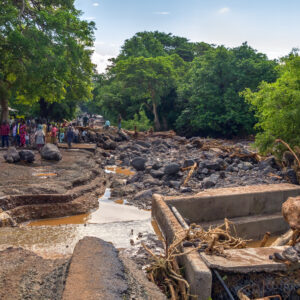Severe weather events such as these are no longer a rare occurrence; they’re more frequent than ever[1], and they’re only projected to get worse due to climate change. Yet, valuable data from the Lloyd’s Register Foundation World Risk Poll found that many populations across the world still do not see climate change as a major threat, leaving them unprepared when disaster strikes.
Here, Dr Sarah Cumbers, Director of Evidence and Insight at Lloyd’s Register Foundation, and Professor Wändi Bruine de Bruin, Provost Professor of Public Policy, Psychology, and Behavioural Science at the University of Southern California, comment on the World Risk Poll data from key regions to understand populations’ attitudes towards severe weather events and climate change – and how to change perceptions.
Understanding risk perceptions
Powered by Gallup, global safety charity Lloyd’s Register Foundation’s latest World Risk Poll surveyed more than 125,000 people across 121 counties to gather insight into what most affects people’s safety globally – and what they feel is the biggest risk to them.
Dr Sarah Cumbers explains: “Our aim with the World Risk Poll was to provide a tool for governments and decision makers to better understand their populations – and it delivers some incredibly valuable insights in this particular instance.
“A majority of respondents in both regions affected by the recent floods agree climate change will be a threat to people in their country within the next 20 years. This is the case for nearly all respondents (92%) in Southern Europe and 64% in Central/Western Africa, though it’s worth noting only two in five respondents in Central/Western Africa (42%) named it ‘a very serious threat’, compared with 72% in Southern Europe.
“In these regions, most people (77% in Central/Western Africa and 75% in Southern Europe) also said they were worried about experiencing serious harm from severe weather.
“Despite these perceptions, only a small number of respondents mentioned climate change when asked to name the greatest threat to their safety (3% in Southern Europe and 2% in Central/Western Africa).”
Psychology can provide crucial answers when it comes to better understanding how people form their risks perceptions, especially when it comes to climate change. Professor Bruine de Bruin explains: “According to the psychology of risk, public perceptions of risk are typically informed in two ways. One way is analytical and based on information people receive about the risk from various experts. Another way is emotional and based on their own experiences.
“In both regions, up to a quarter of people (20% in Southern Europe and 25% in Central/Western Africa) had already experienced a disaster arising from a natural hazard in the last five years. In both regions, floods or heavy rain were the most frequent type of natural hazard experienced. People who have just experienced a flood will therefore be more concerned about flood risk, even if they were aware of the risk before. This is one of the reasons why just after a flood there might be more public support for implementing flood protection.”
Making the invisible visible
So how can policy makers generate public support for implementing climate change mitigation initiatives? The key difference between the two, Professor Bruine de Bruin explains, comes down to visibility: “Floods, and other severe weather events, are very real phenomena that people can directly observe, and that make climate change seem more like an immediate threat.
“However, whether experience with flooding actually increases people’s concerns about climate change depends on whether they are aware of climate change and interpret their flood experience as resulting from climate change.”
Mitigating factors
The World Risk Poll Data shows that the more educated a population, the more likely they are to better understand the correlation between severe weather and climate change – thus perceiving the latter as more of a threat. Professor Bruine de Bruin explains: “People with a college education may be more likely to have learned about climate change in school[2], and to have the scientific literacy and reading comprehension skills needed to understand climate change communications. For example, IPCC (Intergovernmental Panel on Climate Change) reports are quite complex, full of climate science jargon[3], and written at the university level.
“Other factors come into play, including other challenges populations may face, and how omnipresent other major concerns are – such as financial and health concerns. A majority of people in these regions have been identifying severe weather and climate change as serious or somewhat serious threats in the World Risk Poll. But most don’t list severe weather or climate change as the top risk they are concerned about. That’s because in their day to day lives, other risks usually take precedent, like being able to make ends meet and feed your family”.
The role of government
Beyond meeting emission reduction targets, rethinking infrastructure and having better disaster management plans in place, as recommended by the IPCC, there are other things governments can do to help populations feel better prepared, especially when it comes to communications.
Professor Bruine de Bruin says: “To be more effective, climate change communications should be understandable to everyone independent of their level of education. They can also be made more compelling by referring to people’s personal experiences with climate change impacts such as flooding.”
The World Risk Poll data shows there is much work to be done in the way of helping populations mentally connect incidents such as floods with the reality of climate change. Amid increasingly frequent severe weather events, psychology and behavioural science offer useful insights into why populations underestimate climate change as a major threat to their safety. It could also be a source of solutions, too, by demonstrating just how crucial it is for governments and policymakers to focus on raising awareness of the risks climate change carries by highlighting the ways it will directly affect people’s lives.
For more information about the Lloyd’s Register Foundation World Risk Poll, please visit: https://wrp.lrfoundation.org.uk/
[1] ‘The human cost of disasters: an overview of the last 20 years’ (United Nations Office for Disaster Risk Reduction, 2020): undrr.org/publication/human-cost-disasters-overview-last-20-years-2000-2019
[2] ‘On the differential correlates of climate change concerns and severe weather concerns: evidence from the World Risk Poll’ (Wändi Bruine de Bruin & Andrew Dugan, 2022): link.springer.com/article/10.1007/s10584-022-03353-8
[3] ‘Public understanding of climate change terminology’ (Wändi Bruine de Bruin, Lila Rabinovich, Kate Weber, Marianna Babboni, Monica Dean & Lance Ignon. 2021): link.springer.com/article/10.1007/s10584-021-03183-0
Image credits: Shutterstock/Vadim Petrakov






